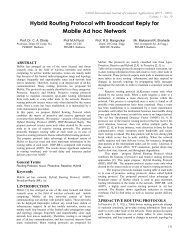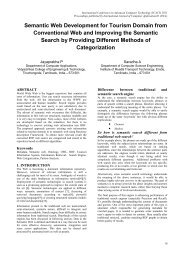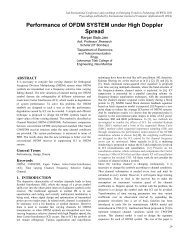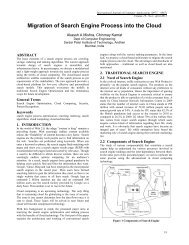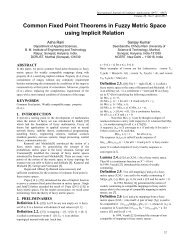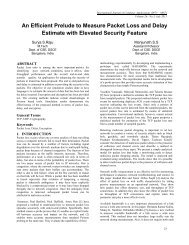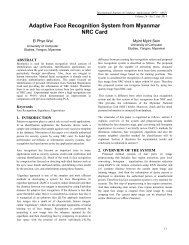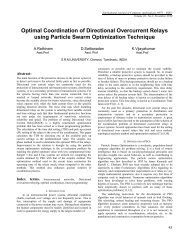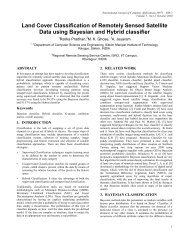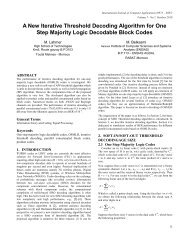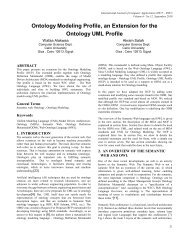A Novel Method of Mining Association Rule with Multilevel Concept ...
A Novel Method of Mining Association Rule with Multilevel Concept ...
A Novel Method of Mining Association Rule with Multilevel Concept ...
Create successful ePaper yourself
Turn your PDF publications into a flip-book with our unique Google optimized e-Paper software.
International Conference on Advanced Computer Technology (ICACT) 2011<br />
Proceedings published by International Journal <strong>of</strong> Computer Applications® (IJCA)<br />
amount <strong>of</strong> data to be processed and also to remove duplicate<br />
records if any <strong>with</strong> different values which may be misleading.<br />
The useless attribute is nothing but the attribute which contains<br />
unique values. Figure 2 shows logic pattern discovery for<br />
duplicate animal list<br />
3.1 Propositional Logic for Coherent <strong>Rule</strong><br />
Generation<br />
The pseudo implications <strong>of</strong> equivalences are called coherent<br />
rules. Not all pseudo implications <strong>of</strong> equivalences can be created<br />
using item sets X and Y. If one pseudo implication <strong>of</strong><br />
equivalence can be created, then another pseudo implication <strong>of</strong><br />
equivalence also coexists. Two pseudo implications <strong>of</strong><br />
equivalences always exist as a pair because they are created<br />
based on the same conditions. Since they share the same<br />
conditions, two pseudo implications <strong>of</strong> equivalences, coexist<br />
having mapped to two logical equivalences. The result is a<br />
coherent rule that meets the same conditions.<br />
Coherent rules meet the necessary and sufficient conditions and<br />
have the truth table values <strong>of</strong> logical equivalence. The coherent<br />
rule consists <strong>of</strong> a pair <strong>of</strong> pseudo implications <strong>of</strong> equivalences that<br />
have higher support values compared to another two pseudo<br />
implications <strong>of</strong> equivalences. Coherent rules are defined based<br />
on logic. This improves the quality <strong>of</strong> association rules<br />
discovered because there are no missing association rules due to<br />
threshold setting. A user can discover all association rules that<br />
are logically correct <strong>with</strong>out having to know the domain<br />
knowledge. This is fundamental to various application domains.<br />
For example, one can discover the relations in a retail business<br />
<strong>with</strong>out having to study the possible relations among items. Any<br />
association rule that is not captured by coherent rules can be<br />
denied its importance. Figure 3 and 4 shows animal support list<br />
and rule list respectively<br />
patterns and strong association rules at the top-most concept<br />
level. With this user can find a set <strong>of</strong> pair-wised frequent items<br />
and a set <strong>of</strong> association rules at each level. The process repeats at<br />
even lower concept levels until no frequent patterns can be<br />
found. During multilevel association rule mining, the taxonomy<br />
information for each (grouped) item is encoded as a sequence <strong>of</strong><br />
digits in the transaction table. Repeated items (i.e., items <strong>with</strong> the<br />
same encoding) at any level will be treated as one item in one<br />
transaction.<br />
In the proposed concept hierarchy model, items may have<br />
different propositional logic and taxonomic relationships to<br />
discover the large item sets. The propositional logic for an item<br />
set is set as the combinatorial sub logic supports <strong>of</strong> the items<br />
contained in the item set, while the propositional logic for an<br />
item at a higher taxonomic concept is set as the minimum sub<br />
logics <strong>of</strong> the items belonging to it. Encoding scheme represents<br />
nodes in the predefined taxonomies for mining multilevel rules.<br />
Figure 5 shows the multiple attribute rule list.<br />
Nodes are encoded <strong>with</strong> respect to their positions in the hierarchy<br />
using sequences <strong>of</strong> numbers and the symbol. It then filters out<br />
unpromising item sets in two phases. In the first phase, an item<br />
group is removed if its occurring count is less than the<br />
propositional logic. In the second phase, the count <strong>of</strong> a<br />
propositional logic rules is checked to determine whether it is<br />
large. The proposed algorithm then finds all the large item sets<br />
for the given transactions by comparing the count <strong>of</strong> each item<br />
set <strong>with</strong> its combinatorial logic.<br />
3.3. Performance Measure On Generated<br />
<strong>Rule</strong>s<br />
The employed multilevel concept hierarchy based association<br />
rule mining using propositional logic is experimented <strong>with</strong><br />
synthetic data to evaluate the association rule and coherent rules<br />
<strong>with</strong>out having the domain knowledge. The results are also<br />
compared <strong>with</strong> logic based pattern discovery model <strong>with</strong> single<br />
level association rule mining model in terms <strong>of</strong> number <strong>of</strong> strong<br />
rules and weak rules generated. Effects <strong>of</strong> non sensitive rules are<br />
derived in both the existing and proposed schemes to show the<br />
efficiency <strong>of</strong> novel association rule mining process.<br />
Figure 3 Support List<br />
Figure 5 Multiple Attribute <strong>Rule</strong> List<br />
Figure 4 <strong>Rule</strong> list<br />
3.2 Multi-Level <strong>Concept</strong> Hierarchy<br />
In multilevel association rules mining, different propositional<br />
logic is used at different concept levels. Discover frequent<br />
The models works well <strong>with</strong> problems involving uncertainty in<br />
data relationships, which are represented by multilevel concepts<br />
for propositional logic rule derivation. The proposed mining<br />
algorithm can thus generate large item sets level by level and<br />
then derive concept multilevel association rules from transaction<br />
dataset. The results shown in the example implies that the<br />
proposed algorithm can derive the multiple-level association<br />
rules under different propositional logic in a simple and effective<br />
way.<br />
28



